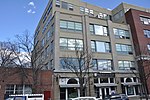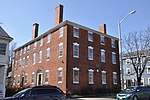Point Neighborhood Historic District

The Point Neighborhood Historic District, also known as Stage Point, is a predominantly residential historic district just south of downtown Salem, Massachusetts. It is a densely built, roughly rectangular grid of streets east of Lafayette Street, south of the South River, west of Congress Street, and north of Chase and Leavitt Streets. This area was the target of a major redevelopment effort undertaken by the city after a fire swept through in 1914. With many multiunit residential buildings constructed in just three years, the architecture of the area is remarkably cohesive. Commercial development is generally restricted to the fringes of the area, on Lafayette Street (a major local thoroughfare) and Congress Street.The district was listed on the National Register of Historic Places in 2014.
Excerpt from the Wikipedia article Point Neighborhood Historic District (License: CC BY-SA 3.0, Authors, Images).Point Neighborhood Historic District
Salem Street, Salem
Geographical coordinates (GPS) Address Nearby Places Show on map
Geographical coordinates (GPS)
| Latitude | Longitude |
|---|---|
| N 42.516666666667 ° | E -70.891388888889 ° |
Address
Salem Street 17
01970 Salem
Massachusetts, United States
Open on Google Maps









